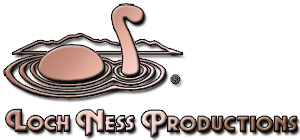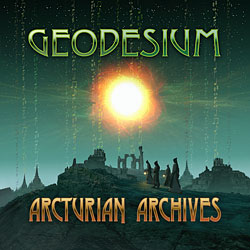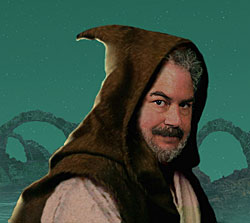Arcturian Archives
Arcturian Archives is an album of music originally created at a time when both the planetarium projector and musical keyboards were undergoing intense technological revolution. As a premier planetarium music composer, Mark C. Petersen was a key figure in the period, creating music that set high standards for creativity. Mark reminisced about the projects he created for during those times and the compositional techniques he used.
"The Digistar Suites were originally created for Evans & Sutherland to accompany demonstration programs of their pioneering planetarium projector system," he said. "Digistar was the world's first digital planetarium projector system, and it took the planetarium world by storm. It was a sensation, and the music I did for its demos had to provide and accompany that sense of excitement and wonder."
For this album, the two Digistar Suites are divided into separate tracks; each suite was originally a single, continuous work without pauses between the movements. The first was recorded in 1989; the second in 1992. Early versions of the first suite actually had a narrator describing what the visuals were, crediting who had created them, and offering a bit of a sales pitch. In the second suite, only the music accompanied the visuals.
Arcturian Archives is rounded out by a set of transcriptions of famous works by Pachelbel, Resphighi and Holst — pieces familiar to Mark as a tuba player in brass quintets and concert bands. Mark pointed out, "I find that performing the works of the 'masters' on synthesizer helps keep me musically inventive and fresh. Taken as a whole, the works on this album span not only music history, but space and time."
All the pieces in the Digistar suites were designed to accompany projected images on the planetarium dome, visions that Mark had before him in video format as he created and mixed the music. The start of Digistar Suite One's Movement 1 was quite visual-specific. "The intro with the 'opening the doors of the observatory' is actually a bit of a planetarium-insider joke," Mark said. "In the classic planetarium, we often created that scene using slide projections and special effects. But, we could never fly out the doors and into space; the old-style starball systems projected a 'fixed sky'. By moving beyond that static image of stars, Digistar was showing how they were leaving the ways of the traditional planetarium behind. I got the dome-opening motor sound effect from Barry Hayes, who was the sound technician at the Digistar planetarium in Richmond Virginia at that time."
The music for the Sierpinski figure is similar to Lightwaves, heard on Mark's album West of the Galaxy. "The Euromast section seemed to me to call for some Euro-pop style of music," Mark recalled. "So I did my Kraftwerk impression for it. There 'may be a price to pay' for borrowing the feel of the opening bars of the Alan Parsons Project Games People Play track, but I think my French horns intro to the orchestral piece sound a little richer."
There are certain elements that become expected in planetarium presentations — classic star talks always show how to use the end stars of the Big Dipper to find Polaris, for example. A staple of many early Digistar shows was a zooming-starfield flight to the Orion Nebula, transporting audiences across space and time. For the St. Louis presentation Gateway To Infinity, Mark came up with a 'star flight to Orion' motif. "I've used that a lot since then," said Mark. "It's basically a fast-paced bass sequence ostinato, with choral chords on top in a I-II-IV progression. You hear that prominently here, and in Flight From Infinity."
Movement 2 got audiences into the 'meat and potatoes' of planetarium fare, demonstrating Digistar's astronomy features. And, it provided a chance for Mark to do his familiar planetarium space music thing, accompanying a spacecraft on its way out of the solar system.
Mark noted "Since we were following the Voyager spacecraft through the orbits of the solar system orrery, I recorded a new version of Voyager from Double Eclipse. It sounds a little crisper and cleaner using mostly digital synths this time around. The choral sounds came from the Emulator; on Double Eclipse, it was from loops of me singing 'Aaaah'! This was a fairly lengthy section of show, so I vamped on the original composition, adding cello leads, and eventually kicking it up a notch by adding a drum kit. The bass sequence is the unifying sound, running throughout while Digistar went through its paces."
Movement 3 accompanied what Mark described as a visually dramatic scene. "You are flying alongside a shuttle as it launches, seeing the SRBs and ET separate right in front of you, doing a graceful cosmic ballet on orbit," he said. "I thought that orchestral build from Pines would work perfectly for the ascent scene. I'd already done the 'on orbit' thing in On Orbit for our own production of The Mars Show. I tied them together with additional choir voices. This led to a dramatic entrance of the ISS, rising up from the horizon, accompanied by a grandiose track called This Way to the Stars from our MUSIC BACK-PACK Library."
Movement 4 underscored visuals that really pushed the boundaries of what a planetarium could do. Fractals, nautilus shells, and black holes were depicted on the dome and in Mark's music. "Zooming into and around these complex figures was just fun to compose music for", said Mark. "I tried to make a joyful sound for falling through 'infinite fractals', and give a 'hollow' sound to the depths of the nautilus shell. The 'angel wing' appearance of the Lorenz attractor inspired a heavenly styling very similar to that used in The Ocean of Space, with the arpeggiator harp. The falling into the gravity well of a black hole was like the psychedelic slit-screen 2001: A Space Odyssey scene. I got to throw in lots of different sounds into the swirling maelstrom; at one of the hit points, I even snuck in a whale call. The Around Orion clip was the music for the credits crawl."
The creation of Digistar Suite Two followed several years later. Mark noted that the general theme of 'Imagination' really opened up some great possibilities for musical interpretation to E&S's visuals.
"1992 was the 500th anniversary of the Columbus's voyage to the New World," Mark said. "The movie 1492: Conquest of Paradise had come out, with Vangelis's fine film score. So of course, the show opened with Digistar illustrating the Santa Maria on the high seas. I tried to give the music a nautical flavor, using a 12/8 meter and a recorder to give it a sort of hornpipe feel. This music later became the theme for our own Loch Ness Productions show, Oceans In Space. Speaking of Vangelis, the Digistar images of closeup flowers reminded me of those on his album Soil Festivities. So I said to myself, 'You know, Vangelis and I play the same instruments — Emulator, Rhodes, synths with sequencers. He had the right idea for these kinds of visuals!' and so I built on it. The other flowers reminded me of an Asian or oriental garden, so that's where the idea to use sitar and bamboo flute sounds came from".
For Movement 2 Mark had both usual and unusual sets of visuals to compose for. "Yet another flight to Orion? Well, after eight years of flying to Orion with the choral motif over a fast sequence, I decided this time we would march instead", said Mark. "I used the same basic sounds and chord progression, but with a martial drum pattern." The raucous music for the Möbius strip roller coaster scene was first recorded for this project. "It was a natural to reprise it for the SpacePark360 project I worked on in 2010; you can hear it in its augmented form as Mo.B.Io's Trip on the Geodesium album Music from SpacePark360. And in the Klein bottle scene, there are actually samples of blowing into jugs and bottles, of course!"
Flight From Infinity comes from a very creative and inventive project — also involving a Digistar system installed in St. Louis, Missouri. "The show Gateway To Infinity was one of the early high points of my career composing for planetarium shows," said Mark. "Things just came together so well, creativity seemed to flow, and the end result was, I feel, an accomplishment well above anything I'd done before. It was like reaching some advanced level of achievement; you're able to build on that peak to move on to bigger and better things thereafter."
Pines of the Appian Way was instrumental in helping Mark land the Gateway To Infinity soundtrack. It was the result of a chance conversation with the show's producer, Hal Donovan.
"During our initial discussions, Hal seemed rather dismissive of my proposed approach to the soundtrack and about synthesizers in general," Mark recalled. "At one point, he commented that he didn't like synthesizers because they sounded thin. I remember stewing about it and thinking to myself, 'He thinks synthesizers sound 'thin'? I'll show him!'"
To make a point about the versatility of synthesizers in soundtrack work, Mark decided to revisit a piece he'd done once before — Resphighi's Pines of the Appian Way. In the 1970s, he was introduced to the piece from its appearance as the finale in the original Laserium planetarium light show. While at Fiske Planetarium, Mark made a 38-track overdubbed realization of the Respighi score, with just the instruments in their sound studio at the time, an EMS Synthi and a Mellotron, and their 8-channel reel-to-reel tape recorder.
Mark described the work it took for that version. "I used a layering technique called 'track bouncing', where you record instrumental tracks filling up all the available tape channels and mix them down to one track on the same tape. Then you erase the originals and record another set of tracks, mix those, and so forth. It's a method fraught with difficulties, since once they're mixed, there's no way to go back and modify any of the tracks thereafter; you had to get it right the first time! And with only one eight-channel tape deck, there was a practical limit on what could be accomplished."
By 1984, Mark's own recording studio had two eight-channel tape decks, so the potential for track bouncing and mixing was increased exponentially. He described the process of recording the second Pines. "I laid down 107 tracks of synthesizer to make this rendition," he said. "Almost every track came from just one synthesizer, a 'new' Sequential Circuits Prophet-5 I had gotten the year before. But, I wasn't completely happy with all of its orchestral percussion sounds. So, I decided to 'cheat' a little. I noted that Wendy Carlos had used real acoustic timpani and cymbals in Pompous Circumstances, her take on Elgar's famous work. So, I figured I could get away with it, too."
As luck would have it, Mark was playing in the Boulder Concert Band at the time. "One night after rehearsal," he recalled, "I set up my recording gear, and performed the timpani, cymbals, and tam-tam (gong) parts on real percussion instruments, wearing headphones to hear the other tracks in a temporary mix while I played."
Finally, it was time to meet again with Donovan, and Mark had a special presentation in mind. He knew the McDonnell Planetarium in St. Louis would have a six-channel theatrical surround sound system. "I decided to give Hal a demo sound that would emulate what his own theater would have," said Mark. "So I made a surround mix of Pines, and sent it to Texas to have it printed onto mag-coat 35mm film. Then, I arranged for a private after-hours "screening" time at the recently-opened IMAX theater in the Denver Museum of Natural History (now renamed the Denver Museum of Nature and Science). We went in, the audio film platter was loaded, and Hal listened stoically while being washed in the six-channel surround sound of the music. After it finished, he turned to me and said, 'Okay, that didn't sound thin.' And, I got the job of doing the soundtrack for Gateway To Infinity."
Mark pointed out another good outcome of his triumphantly persuasive actions — one that would change the style and substance of his performing career. "While Hal was in town, I took him to visit Keyboard Exchange (a local music instrument store) to see the latest keyboard technology," he said. "E-Mu Systems had just introduced their sampling keyboard, the Emulator II, and so we got to play with it for quite a while that afternoon. I had a major case of keyboard lust!"
Donovan was impressed, to the extent that a requirement was actually put into Mark's contract that he must use the Emulator II in the Gateway To Infinity soundtrack. "It was a major purchase for me," said Mark,"but it was worth it. It added a whole new dimension and depth to my music from that point onward. I was no longer limited to the sounds generated by analog oscillators. My compositional sound palette became incredibly more diverse."
Pachelbel's Kanon in D was Mark's first multitrack project with the Emulator. "I had to learn what all it could do and how to program it," Mark recalled. "So it was time to try out some of the 'factory' sounds that came with it, and to make some new ones too. The hammered dulcimer sound came from an actual hammered dulcimer Carolyn had made. I built a sample set, along with the trumpet and other brass instrument samples. In the early days, obtaining and sharing samples for use with the Emulator II wasn't easy; there was no Internet then. I sent my sounds to E-Mu Systems, and they were later incorporated and distributed in the Emulator II Sample Library. Later on, more legato orchestral strings were eventually added to the Library, which would have been really useful to have, instead of the Marcato Strings that came with the initial release of the keyboard and were used here."
1988 was the year of Mars, and Mark was preparing for a rare Celestial Rhythms concert with Jonn Serrie and Barrie Hayes. The finale was Gustav Holst's Mars, the Bringer of War. Mark said, "I had a great model to follow in recreating Holst's score: Emerson, Lake and Powell had recorded a rocked-up version on their self-titled album the year before. I liked the Cozy Powell backbeat and the Lucky Man portamento synth lead solo ideas in their arrangement, and I took inspiration for some of the voicings from Isao Tomita's version too. In the studio, I actually worked from the conductor's score of the Boosey & Hawkes published orchestral version. It's quite remarkable how close to the original score Keith Emerson stayed."
For the concert, Mark was able to play a lot of the brass lines live. "That did take a lot of practice!" he said. "For the rock-synth solo section, Barry and I both had strap-on keytars (guitar-style MIDI keyboard controllers). We put them on and leapt off the stage into the audience, trading fours while standing in the aisles, with lasers from the back of the theater shooting beams overhead though the theatrical smoke and fog! We didn't get as crazy as Keith Emerson would have, shooting pyrotechnics out the ends of the instruments, but still — it was a wild time. It doesn't get much better than that!"




